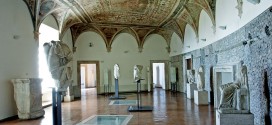The old palace was built by Colonna family on the structures of semi cycle above the Sanctuary of Fortuna Primigenia around 1050, when family settled at Palestrina.
The building underwent a first destruction in 1298, when Palestrina, after a siege that lasted nearly a year, was compleatly destroyed on demande of Boniface VIII, who had ordered the confiscation of family’s property because they tried to contest his election. After the defeat, Colonna family signed a document of submission to the Pope which testifies the look of the Palace at that time and damage that it suffered. The Palace had two towers on sides and was military fortress that had control over the city and properties below.
The city was soon rebuilt, together with residence of the Princes, but suffered a second big devastation in 1437 by Eugenius IV who disagreed with Colonna family, and gave orders to Cardinal Vitelleschi, head of Papal troops, to attack Palestrina.
The successor of Eugenius IV gave the prenestin Princes their land and agreed the reconstruction of the city and the Palace: the Colonnade was closed and the building splits in two floors. It seems that around 1450 Leone Battista Alberti, famous humanist and architec has stayed at the Palace.
Between 1450 and 1500 Francesco Colonna rebuilt again the Palace, adding to the centre of the semicircular stairway octagonal well crowned with two columns; the portal was created in 1498, closely connected with contemporary Palace of Santa Croce at Rome; the windows were enlarged and placed symmetrically.
The Palace stands out from other Roman buildings built on ancient monuments for the conscious choice of its form, that represents a desired synthesis between ancient and modern, a successful product of Renaissance design that influenced even the Bramante, who proposed its appearance to Belvedere of Vatican.
Maurizio Calvesi identifies Francesco Colonna as the architect of the Palace. Calvesi was the author of the Hypnerotomachia Poliphili (Battle of love in a dream of Poliphilo), famous book printed in 1499, adorned with engravings attributed to Mantegna, Giovanni Bellini, Raphael, and for its typhography considered the most beuatiful book of Renaissance and one of the most significant books that provides documentary evidences of the history of architecture and doctrines of figurative arts.
In 1630 Colonna family sold the city and the Palace to Carlo Barberini, brother of Urban VIII, for 775,000 ecu. Ten years later the building was rebuilt in its present form by Taddeo Barberini; the same year Cardinal Francis, Taddeo’s brother, placed the famous Nile mosaic. Few years later the adjoining Church of St. Rosalia was built by Francesco Contini, commissioned by Maffeo Barberini in gratitude for the salvation of the city from epidemic plague; for a long time here was preserved Pietà Barberini made by Michelangelo, today kept at Accademia Gallery in Florence.
 Archeopalestrina Percorso archeologico di Palestrina, l'antica Praeneste
Archeopalestrina Percorso archeologico di Palestrina, l'antica Praeneste

